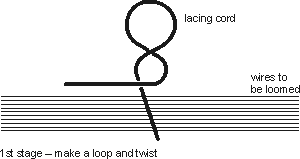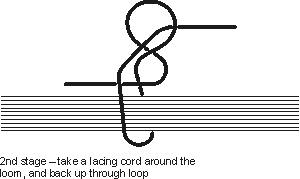How to use Cable Ties and Lacing Cord in Cable Looms
Key hints and tips about how to use lacing cord or cable ties (tie-wraps) to keep cable forms tidy and in place.
Home » Construction & manufacture » this page
Construction Hints & Tips Includes:
Practical hints & tips overview
How to make twisted pair wire
How to drill cases that are painted
How to use heat shrink sleeving
How to tidy wiring with looms
How to straighten kinked connecting wire
Bending & forming axial component leads
Using ferrite rings to cure power line interference
Often when building and soldering an electronics project, there are plenty of wires that need to be included. These wires often need to be taken between a printed circuit board PCB, and front panel controls or connectors, or to other boards or modules within the finished unit. These wires can easily end up looking very untidy, as well as being likely to break if they are moved to often. To ensure that the wires are nicely anchored so they do not bend back and forth which may cause them to break, and also to make the electronics construction project look much neater and more professional it helps to bundle the wires into a loom and anchor them at suitable points in the case which contains the electronics.
There are two ways in which untidy wires can be held together, made to look far more tidy, and also anchored together in a way that will provide support and reduce the likelihood of broken wires:
- Use of cable ties or tie-wraps
- Use of cable looming techniques with lacing cord
Basic ideas for wiring looms
While the idea of creating a loom for a project may seem a bit over the top, it can sometimes prove to be beneficial, however there are a few basic ideas and guidelines that should be observed.
It is best not to include mains wire in with the loom with other wiring for safety, and to prevent unwanted mains hum pick-up. In any case, great care must be taken when dealing with any mains wiring to ensure the maximum safety at all times.
If a wiring loom is to be used in a piece of equipment, the best route should be thought out in advance. All wires can then be cut to length accordingly.
When cutting the wires for a loom, it is best to leave a little extra length to ensure it is long enough, and not just that little bit too short. Any extra length can easily be lost in the loom, or more usually by taking a longer loop from the loom to the connection point.
Using cable ties
Cable ties are particularly easy to use to gather wires together in the form of a wiring loom, or to anchor a wire around a particular binding point. The cable tie consists of a small flat length of plastic with serrations along one of the flat surfaces. At one end of the length is a simple small ratchet assembly in a small open housing. The free end of the cable tie can be placed through the hole in the ratchet assembly and pulled tight. Once the serrations on the flat section of the cable tie have engaged the ratchet it is prevented from being pulled back. As a result the loop created may only be pulled tighter.
When using a cable tie it is wise not to fully tighten it until all the wires are in place and the item has been tested. In this way it will be possible to insert further wires into the loom if required. Only when all is satisfactory should all the cable ties be tightened. Additionally a cable tie should not be over-tightened so that it cuts into the insulation of the wires. The tension of the cable tie should be sufficient to hold the wires securely in place.
Cable ties are generally considered as being single use items. If a cable tie needs to be removed, it is generally cut off, ensuring that no damage occurs to the wires. However it is possible to re-use them on some occasions. It is possible to insert a small pointed object into the ratchet, it may be possible to release its grip and undo the cable tie. As cable ties are normally very cheap, it may be easier to cut them off, and use new ones. Additionally access to the areas where the cable ties are located may be limited and this may prevent them being removed without cutting them off.
There are some reusable cable ties. These can consist of a number of forms, but they may be more easily removed and re-used than the standard types.
A further advantage of cable ties is that special anchor points can be purchased. These have adhesive backs from which a thin protective layer can be peeled, enabling the anchor point to be stuck in a suitable position. The cable tie can then be passed through a hole in the anchor point, and this can then be used to anchor the wiring in place.
Cable looming using lacing cord
Once complete the loom can be laced together. It is best to use proper lacing cord which can be obtained from most component dealers. It makes a much better job than trying to improvise.
The basic knot used is shown (diagrams to be added shortly). This is created in two simple stages:
- Create a loop by twisting the lacing cord as shown.

Using lacing cord within a cable loom - Pass the lacing cord around the wires to be bundled together and included in the loom, and then pass it through the loop previously made.

Using lacing cord within a cable loom - Tighten the lacing cord to the required tightness.
It is best to practise it before trying it on a real piece of equipment. Although the knot may appear to be complicated, it is in reality quite simple to do.
Knots should be tight enough to stay in position without cutting in to the wires. Also the cord between the knots should be tight and not have any slack. The loom can be started and finished by tying two knots on top of each other.
Summary
When building an electronics project, gathering the wires together in the form of a loom can add considerably to the professional look of the project. It can also improve the reliability, as wires will not be loose and able to move and bend wit the resultant risk of breaking the wire at the point of the soldered joints. While looms have many advantages, care must be taken if there is a risk of stray signal pick-up. As the wires are run in close proximity and parallel to each other, this will considerably increase the level of pick-up. If this is likely to be a problem, any susceptible wires should not be run in the cable loom, but taken via a different route.
Of the various methods used for cable looming and containment, the cable tie has become the most widely used in many instances. Cable ties are cheap to buy and easily available through many component stockists.
 Written by Ian Poole .
Written by Ian Poole .
Experienced electronics engineer and author.
More Construction Ideas & Concepts:
Soldering
SMT component soldering
ESD - Electro-Static Discharge
PCB manufacture
PCB assembly
Return to Constructional Techniques menu . . .




